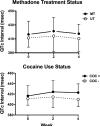Effects of disulfiram on QTc interval in non-opioid-dependent and methadone-treated cocaine-dependent patients
- PMID: 23648640
- PMCID: PMC3737260
- DOI: 10.1097/ADM.0b013e3182928e02
Effects of disulfiram on QTc interval in non-opioid-dependent and methadone-treated cocaine-dependent patients
Abstract
Objectives: Methadone and cocaine are each known to prolong the QTc interval, a risk factor for developing potentially fatal cardiac arrhythmias. Disulfiram, often administered in the context of methadone maintenance to facilitate alcohol abstinence, has been shown to have some efficacy for cocaine dependence. Disulfiram has differential effects on cocaine and methadone metabolism, but its impact on methadone- or cocaine-induced changes in QTc interval is unclear. Thus, the effects of disulfiram on QTc interval in a subset of cocaine-dependent patients participating in a 14-week, randomized, double-blind, placebo-controlled clinical trial of disulfiram were prospectively determined.
Methods: Opioid-dependent participants were inducted onto methadone (weeks 1-2; MT) and both MT and non-opioid-dependent (UT) participants were randomized to receive disulfiram (weeks 3-14) at one of the following doses: 0, 250, 375, or 500 mg/d. Electrocardio-grams were obtained before study entry and during weeks 2 and 4.
Results: Complete QTc-interval data in 23 MT and 18 UT participants were analyzed. QTc interval tended to be higher in MT participants relative to UT participants, regardless of disulfiram dose and time point, but disulfiram did not differentially alter QTc interval. QTc interval was, however, significantly greater in participants with recent cocaine use than in those with no recent use.
Conclusions: These results suggest that cocaine use and possibly MT status, but not disulfiram, are risk factors for QTc prolongation.
Figures


Similar articles
-
A randomized clinical trial of disulfiram at higher doses for the treatment of cocaine use disorder among methadone-stabilized patients.J Psychiatr Res. 2025 Jun;186:387-395. doi: 10.1016/j.jpsychires.2025.04.051. Epub 2025 Apr 26. J Psychiatr Res. 2025. PMID: 40306006 Clinical Trial.
-
Randomized, double blind, placebo-controlled trial of disulfiram for the treatment of cocaine dependence in methadone-stabilized patients.Drug Alcohol Depend. 2011 Jan 15;113(2-3):184-91. doi: 10.1016/j.drugalcdep.2010.07.022. Epub 2010 Sep 15. Drug Alcohol Depend. 2011. PMID: 20828943 Free PMC article. Clinical Trial.
-
Efficacy of disulfiram and Twelve Step Facilitation in cocaine-dependent individuals maintained on methadone: a randomized placebo-controlled trial.Drug Alcohol Depend. 2012 Nov 1;126(1-2):224-31. doi: 10.1016/j.drugalcdep.2012.05.019. Epub 2012 Jun 12. Drug Alcohol Depend. 2012. PMID: 22695473 Free PMC article. Clinical Trial.
-
The safety of disulfiram for the treatment of alcohol and cocaine dependence in randomized clinical trials: guidance for clinical practice.Expert Opin Drug Saf. 2008 Jul;7(4):459-72. doi: 10.1517/14740338.7.4.459. Expert Opin Drug Saf. 2008. PMID: 18613809 Review.
-
The status of disulfiram: a half of a century later.J Clin Psychopharmacol. 2006 Jun;26(3):290-302. doi: 10.1097/01.jcp.0000222512.25649.08. J Clin Psychopharmacol. 2006. PMID: 16702894 Review.
Cited by
-
A randomized clinical trial of disulfiram at higher doses for the treatment of cocaine use disorder among methadone-stabilized patients.J Psychiatr Res. 2025 Jun;186:387-395. doi: 10.1016/j.jpsychires.2025.04.051. Epub 2025 Apr 26. J Psychiatr Res. 2025. PMID: 40306006 Clinical Trial.
-
Disulfiram for the treatment of cocaine dependence.Cochrane Database Syst Rev. 2024 Jan 5;1(1):CD007024. doi: 10.1002/14651858.CD007024.pub3. Cochrane Database Syst Rev. 2024. PMID: 38180268 Free PMC article.
References
-
- Carroll KM, Fenton LR, Ball SA, Nich C, Frankforter TL, Shi J, Rounsaville BJ. Efficacy of disulfiram and cognitive behavior therapy in cocaine-dependent outpatients: a randomized placebo-controlled trial. Archives of General Psychiatry. 2004;61(3):264–272. doi: 10.1001/archpsyc.61.3.264 [doi] 61/3/264 [pii] - PMC - PubMed
-
- Carroll KM, Rounsaville BJ, Bryant KJ. Alcoholism in treatment-seeking cocaine abusers: clinical and prognostic significance. J Stud Alcohol. 1993;54(2):199–208. - PubMed
-
- Chang K, Huang C, Liang H, Chang S, Wang Y, Liang W, Huang S. Gender-Specific Differences in Susceptibility to Low-Dose Methadone-Associated QTc Prolongation in Patients with Heroin Dependence. Journal of Cardiovascular Electrophysiology. 2012;23(5):527–533. doi: 10.1111/j.1540-8167.2011.02231.x. - PubMed
-
- Charuvastra CV, Panell J, Hopper M, Erhmann M, Blakis M, Ling W. The Medical Safety of the Combined Usage of Disulfiram and Methadone: Pharmacological Treatment for Alcoholic Heroin Addicts. Arch Gen Psychiatry. 1976;33:391–393. - PubMed
Publication types
MeSH terms
Substances
Grants and funding
LinkOut - more resources
Full Text Sources
Other Literature Sources
Medical

